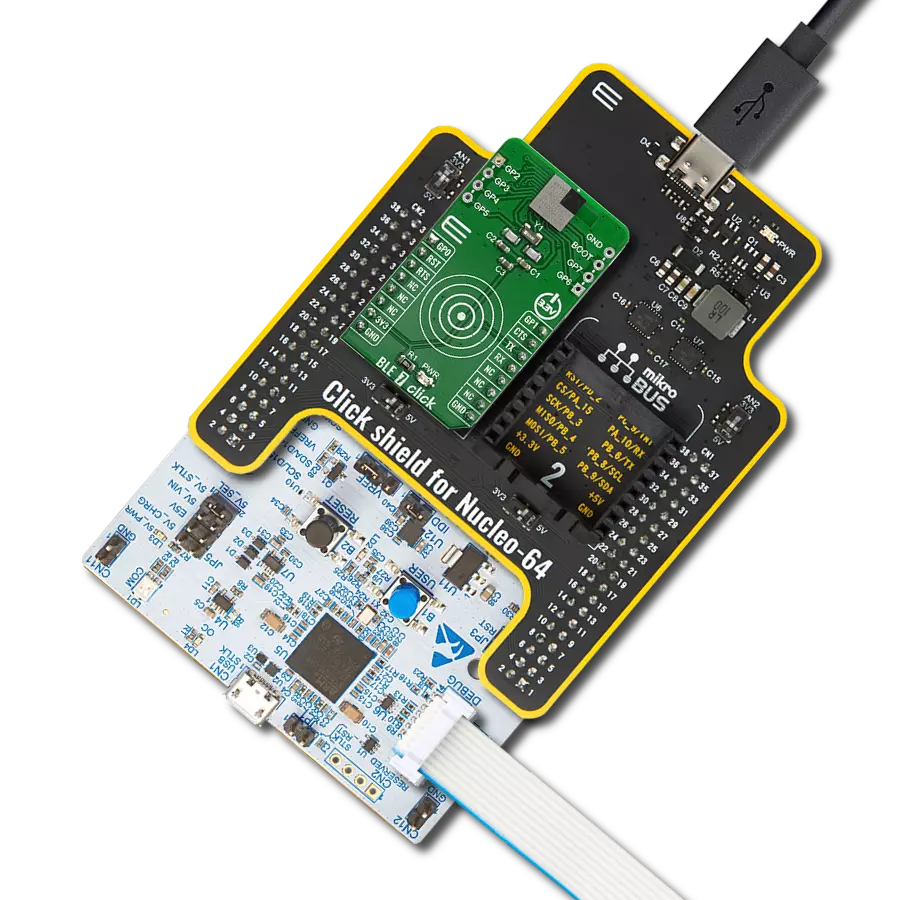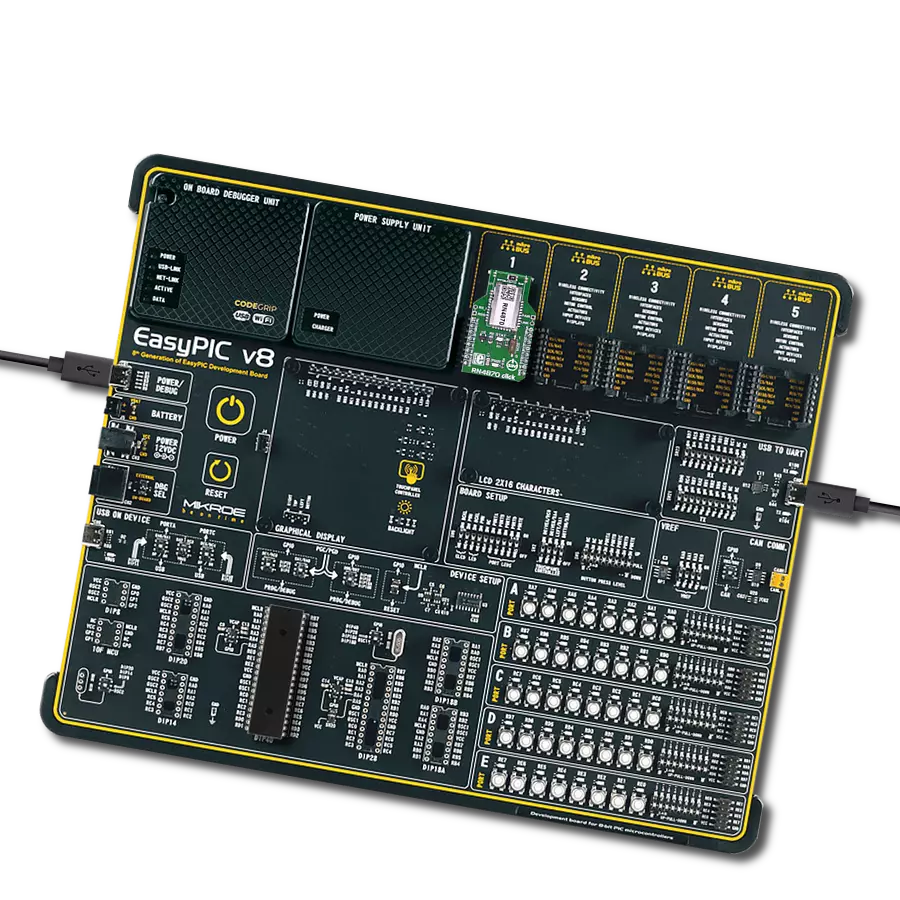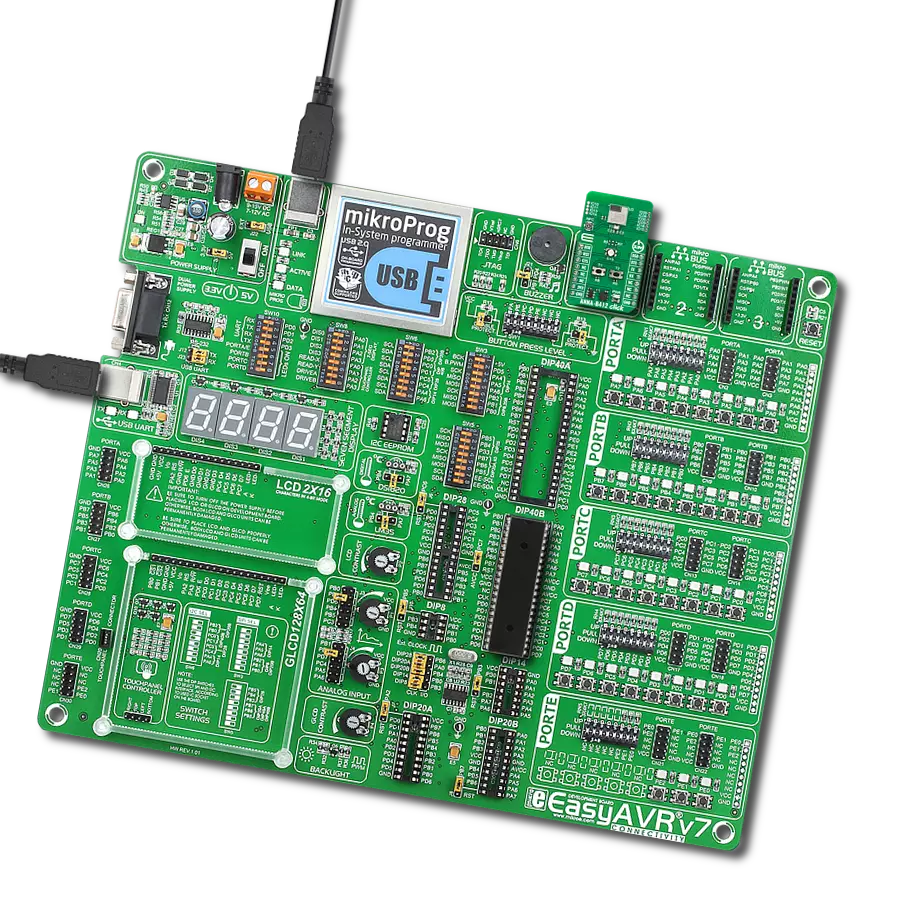无缝集成BLE功能到物联网系统中,创建先进的连接设备,面向连接的消费者、医疗、智能家居和家电应用的前沿。
A
A
硬件概览
它是如何工作的?
BLE TINY Click基于DA14531MOD,这是一款基于全球最小、功耗最低的Dialog Semiconductor蓝牙5.1系统芯片(SoC)的SmartBond TINY™模块。DA14531基于强大的32位Arm Cortex-M0+,集成了内存以及模拟和数字外设。它配备了下一代Codeless软件,使得设计蓝牙应用程序无需蓝牙知识或高级编程技能,通过全面的AT命令集即可实现。该模块配备软件,以降低使用BLE技术的门槛。DA14531具有可配置的DSPS(串行端口服务)和下一代Codeless软件,设计蓝牙应用程序无需蓝牙知识或高级编程技能。它专门优化以显著降低为IoT系统添加蓝牙低能耗功能的成本。SmartBond TINY模块已通过全球认证,包括美洲的联邦通信委员会(FCC)
认证和欧洲的CE认证。BLE TINY Click使用单线UART接口作为与MCU通信的默认通信协议,用于与主机交换AT命令和数据传输。一个标记为1WIRE EN的开关用于激活这种通信,使模块能够通过单线UART接收和发送引脚或仅通过标准UART TX引脚建立通信。该Click板™使用74LVC1G3157多路复用器,以避免与由相同GPIO驱动的其他功能发生冲突。这样,用户可以使用P0_6引脚,该引脚具有双重功能,可用作UART TX引脚或用于ADC的模拟引脚。通过填充标记为P0_6 SEL的相应跳线选择该引脚的功能。DA14531预设有默认配置。然而,由于GPIO引脚数量少,多个功能被多路复用,并可通过板载跳线根据需要启用。用户还可以使用其他
接口,如SPI或I2C,通过填充相应跳线(P0_11和P0_9 SEL)自行配置模块并编写库。BLE TINY Click还提供带有SWDIO数据和SWCLK时钟信号的JTAG接口在J1头上。这样,用户可以通过JTAG接口为DA14531模块编程特定版本的Codeless软件。此外,通过将该引脚设置为高逻辑电平,可以通过mikroBUS™插座上的硬件复位引脚(标记为RST)复位此Click板™。此Click板™只能在3.3V逻辑电压电平下运行。使用具有不同逻辑电平的MCU之前,必须进行适当的逻辑电压电平转换。此外,它还配备了一个库,包含功能和示例代码,可作为进一步开发的参考。
功能概述
开发板
Clicker 2 for Kinetis 是一款紧凑型入门开发板,它将 Click 板™的灵活性带给您喜爱的微控制器,使其成为实现您想法的完美入门套件。它配备了一款板载 32 位 ARM Cortex-M4F 微控制器,NXP 半导体公司的 MK64FN1M0VDC12,两个 mikroBUS™ 插槽用于 Click 板™连接,一个 USB 连接器,LED 指示灯,按钮,一个 JTAG 程序员连接器以及两个 26 针头用于与外部电子设备的接口。其紧凑的设计和清晰、易识别的丝网标记让您能够迅速构建具有独特功能和特性
的小工具。Clicker 2 for Kinetis 开发套件的每个部分 都包含了使同一板块运行最高效的必要组件。除了可以选择 Clicker 2 for Kinetis 的编程方式,使用 USB HID mikroBootloader 或外部 mikroProg 连接器进行 Kinetis 编程外,Clicker 2 板还包括一个干净且调节过的开发套件电源供应模块。它提供了两种供电方式;通过 USB Micro-B 电缆,其中板载电压调节器为板上每个组件提供适当的电压水平,或使用锂聚合物 电池通过板载电池连接器供电。所有 mikroBUS™ 本
身支持的通信方法都在这块板上,包括已经建立良好的 mikroBUS™ 插槽、重置按钮和几个用户可配置的按钮及 LED 指示灯。Clicker 2 for Kinetis 是 Mikroe 生态系统的一个组成部分,允许您在几分钟内创建新的应用程序。它由 Mikroe 软件工具原生支持,得益于大量不同的 Click 板™(超过一千块板),其数量每天都在增长,它涵盖了原型制作的许多方面。
微控制器概述
MCU卡片 / MCU

建筑
ARM Cortex-M4
MCU 内存 (KB)
1024
硅供应商
NXP
引脚数
121
RAM (字节)
262144
使用的MCU引脚
mikroBUS™映射器
“仔细看看!”
Click board™ 原理图

一步一步来
项目组装
实时跟踪您的结果
应用程序输出
1. 应用程序输出 - 在调试模式下,“应用程序输出”窗口支持实时数据监控,直接提供执行结果的可视化。请按照提供的教程正确配置环境,以确保数据正确显示。

2. UART 终端 - 使用UART Terminal通过USB to UART converter监视数据传输,实现Click board™与开发系统之间的直接通信。请根据项目需求配置波特率和其他串行设置,以确保正常运行。有关分步设置说明,请参考提供的教程。

3. Plot 输出 - Plot功能提供了一种强大的方式来可视化实时传感器数据,使趋势分析、调试和多个数据点的对比变得更加直观。要正确设置,请按照提供的教程,其中包含使用Plot功能显示Click board™读数的分步示例。在代码中使用Plot功能时,请使用以下函数:plot(insert_graph_name, variable_name);。这是一个通用格式,用户需要将“insert_graph_name”替换为实际图表名称,并将“variable_name”替换为要显示的参数。

软件支持
库描述
该库包含 BLE TINY Click 驱动程序的 API。
关键功能:
bletiny_send_cmd- 发送命令功能bletiny_i2c_config- 配置Click板以进行I2C主通信bletiny_i2c_write- 通过I2C通信向从设备的寄存器地址写入数据的发送命令
开源
代码示例
完整的应用程序代码和一个现成的项目可以通过NECTO Studio包管理器直接安装到NECTO Studio。 应用程序代码也可以在MIKROE的GitHub账户中找到。
/*!
* @file main.c
* @brief BLE TINY Click Example.
*
* # Description
* This example reads and processes data from BLE TINY clicks.
* Application waits for connection with Click board with phone.
* Then checks its Coadless FW version and checks connected device.
* Then waits for command to be stored in it's memory on 0 slot.
* After that depending on the command stored it executes that type of example.
*
* The demo application is composed of two sections :
*
* ## Application Init
* Initializes driver and resets device and seds Disconnect and Reset IO commands.
* Then it waits for the connection to device. When connected it sends commands to
* check Coadless FW, connected device, its BLE address and signal quality of
* connection. In the end it waits for command from its memory. After valid
* command is stored in memory on 0 slot it contines to Application Task.
*
* ## Application Task
* Executes one of thre application task selected in Application Init:I2C, SPI, APP.
* I2C example uses EEPROM Click board to write and read data of its memory.
* SPI example uses EEPROM 2 Click board to write and read data of its memory.
* APP example just reads UART data and logs it to UART Terminal.
*
* ## Additional Function
* - static void bletiny_clear_app_buf ( void )
* - static err_t bletiny_process ( void )
* - static void bletiny_error_check( err_t error_flag );
* - static void bletiny_log_app_buf ( void );
* - static err_t bletiny_rsp_check ( void );
* - static void bletiny_example_init ( void );
* - static void bletiny_application_example ( void );
* - static void bletiny_i2c_example ( void );
* - static void bletiny_spi_example ( void );
*
* @note
* For this application you need to install Dialog's mobile application SmartConsole.
* This application I2C example is created using EEPROM Click board, and for SPI
* example EEPROM 2 Click board is used.
*
* @author Luka Filipovic
*
*/
#include "board.h"
#include "log.h"
#include "bletiny.h"
#include "conversions.h"
/**
* @brief Application receiver buffer size
* @details Specified size of application receiver buffer.
*/
#define PROCESS_BUFFER_SIZE 200
/**
* @brief Application example type.
* @details Specified application example type.
*/
typedef enum
{
BLETINY_APP_CTRL,
BLETINY_I2C_EXAMPLE,
BLETINY_SPI_EXAMPLE
}bletiny_example_type_t;
/**
* @brief Application example state.
* @details Specified application example state.
*/
typedef enum
{
BLETINY_CONFIGURE_MASTER,
BLETINY_CONFIGURE_SLAVE,
BLETINY_EXAMPLE
}bletiny_example_state_t;
static bletiny_t bletiny;
static log_t logger;
/**
* @brief Application @b app_buf and its @b app_buf_cnt and @b app_buf_len.
* @details Application receiver buffer and its counter and current length.
*/
static char app_buf[ PROCESS_BUFFER_SIZE ] = { 0 };
static int32_t app_buf_len = 0;
static int32_t app_buf_cnt = 0;
/**
* @brief Application example type and state.
* @details Application example type and state variables.
*/
static bletiny_example_type_t example_type;
static bletiny_example_state_t example_state;
/**
* @brief Clearing application buffer.
* @details This function clears memory of application buffer and reset it's length and counter.
*/
static void bletiny_clear_app_buf ( void );
/**
* @brief Data reading function.
* @details This function reads data from device and concatenates data to application buffer.
*
* @return @li @c 0 - Read some data.
* @li @c -1 - Nothing is read.
* @li @c -2 - Application buffer overflow.
*
* See #err_t definition for detailed explanation.
*/
static err_t bletiny_process ( void );
/**
* @brief Parse errors.
* @details This function checks for different types of errors and logs them on UART.
*/
static void bletiny_error_check( err_t error_flag );
/**
* @brief Logs application buffer.
* @details This function logs data from application buffer.
*/
static void bletiny_log_app_buf ( void );
/**
* @brief Response check.
* @details This function checks for response and returns the status of response.
*
* @return @li @c >=0 - Success,
* @li @c <0 - Error.
*
* See #err_t definition for detailed explanation.
*/
static err_t bletiny_rsp_check ( void );
/**
* @brief Selecting application task.
* @details This function selects application task that will be executed.
* @note Select task by sending command for sending string in memory(0 slot)
* with phone application. Example of command: AT+MEM=0,I2C. If memory is
* not empty the string detected will be shown on UART Terminal.
*/
static void bletiny_example_init ( void );
/**
* @brief Application example.
* @details This function executes task for using phone application.
* @note Example logs if any data is read from Click board. This example
* should be selected if you want to control device with phone application.
*/
static void bletiny_application_example ( void );
/**
* @brief I2C example.
* @details This function executes task for using EEPROM Click board.
* @note Example configures IO pins for I2C communication and configures I2C.
* Then writes "MikroE" to memory of EEPROM Click board and then reads it
* back and logs it to UART Terminal.
*/
static void bletiny_i2c_example ( void );
/**
* @brief SPI example.
* @details This function executes task for using EEPROM 2 Click board.
* @note Example configures IO pins for SPI communication and configures SPI.
* When configured, it sends command for enableing write to Click board memory.
* Then writes "MikroE" to memory of EEPROM 2 Click board and then reads it
* back and logs it to UART Terminal.
*/
static void bletiny_spi_example ( void );
/**
* @brief Clear every @b chr from @b str.
* @details This function clears every occurance of @b chr from @b str.
*/
static void bletiny_clear_char( uint8_t *str, char chr );
void application_init ( void )
{
log_cfg_t log_cfg; /**< Logger config object. */
bletiny_cfg_t bletiny_cfg; /**< Click config object. */
/**
* Logger initialization.
* Default baud rate: 115200
* Default log level: LOG_LEVEL_DEBUG
* @note If USB_UART_RX and USB_UART_TX
* are defined as HAL_PIN_NC, you will
* need to define them manually for log to work.
* See @b LOG_MAP_USB_UART macro definition for detailed explanation.
*/
LOG_MAP_USB_UART( log_cfg );
log_init( &logger, &log_cfg );
log_printf( &logger, "\r\nApplication Init\r\n" );
Delay_ms( 1000 );
// Click initialization.
bletiny_cfg_setup( &bletiny_cfg );
BLETINY_MAP_MIKROBUS( bletiny_cfg, MIKROBUS_1 );
err_t init_flag = bletiny_init( &bletiny, &bletiny_cfg );
if ( init_flag == UART_ERROR )
{
log_error( &logger, " Application Init Error. " );
log_info( &logger, " Please, run program again... " );
for ( ; ; );
}
bletiny_default_cfg ( &bletiny );
bletiny_send_cmd( &bletiny, BLETINY_CMD_ATR );
bletiny_send_cmd( &bletiny, BLETINY_CMD_ATZ );
bletiny_send_cmd( &bletiny, BLETINY_CMD_GAPDISCONNECT );
bletiny_process( );
bletiny_clear_app_buf( );
app_buf_len = 0;
app_buf_cnt = 0;
//wait for connection
log_printf( &logger, " Waiting for phone to connect\r\n" );
while ( 0 == strstr( app_buf, BLETINY_CONNECTED ) )
{
bletiny_process( );
}
log_printf( &logger, " Connected\r\n" );
bletiny_clear_app_buf( );
//send ATI command to check Codless FW
bletiny_send_cmd( &bletiny, BLETINY_CMD_ATI );
volatile err_t app_error_flag = bletiny_rsp_check();
if ( BLETINY_OK == app_error_flag )
{
bletiny_log_app_buf();
log_printf( &logger, "-----------------------------------\r\n" );
}
else
{
bletiny_error_check( app_error_flag );
}
Delay_ms( 1000 );
//send command to check ble address
bletiny_send_cmd( &bletiny, BLETINY_CMD_BDADDR );
app_error_flag = bletiny_rsp_check();
if ( BLETINY_OK == app_error_flag )
{
bletiny_log_app_buf();
log_printf( &logger, "-----------------------------------\r\n" );
}
else
{
bletiny_error_check( app_error_flag );
}
Delay_ms( 1000 );
//send ATrI command to check remote connected device
bletiny_send_cmd( &bletiny, BLETINY_CMD_ATRI );
app_error_flag = bletiny_rsp_check();
if ( BLETINY_OK == app_error_flag )
{
bletiny_log_app_buf();
log_printf( &logger, "-----------------------------------\r\n" );
}
else
{
bletiny_error_check( app_error_flag );
}
Delay_ms( 1000 );
//send RSSI command to check signal quality
bletiny_send_cmd( &bletiny, BLETINY_CMD_RSSI );
app_error_flag = bletiny_rsp_check();
if ( BLETINY_OK == app_error_flag )
{
bletiny_log_app_buf();
log_printf( &logger, "-----------------------------------\r\n" );
}
else
{
bletiny_error_check( app_error_flag );
}
//select example to execute
bletiny_example_init( );
bletiny_clear_app_buf( );
log_printf( &logger, " Application Task \r\n" );
}
void application_task ( void )
{
static uint8_t info = 0;
switch ( example_type )
{
case BLETINY_I2C_EXAMPLE:
{
if (!info)
{
info++;
log_printf( &logger, " I2C example\r\n" );
bletiny_process( );
bletiny_clear_app_buf( );
}
bletiny_i2c_example( );
break;
}
case BLETINY_SPI_EXAMPLE:
{
if (!info)
{
info++;
log_printf( &logger, " SPI example\r\n" );
bletiny_process( );
bletiny_clear_app_buf( );
}
bletiny_spi_example( );
break;
}
case BLETINY_APP_CTRL:
{
if (!info)
{
info++;
log_printf( &logger, " Application example\r\n" );
bletiny_process( );
bletiny_clear_app_buf( );
}
bletiny_application_example( );
break;
}
default:
{
break;
}
}
}
void main ( void )
{
application_init( );
for ( ; ; )
{
application_task( );
}
}
static void bletiny_clear_app_buf ( void )
{
memset( app_buf, 0, app_buf_len );
app_buf_len = 0;
app_buf_cnt = 0;
}
static err_t bletiny_process ( void )
{
int32_t rx_size;
char rx_buff[ PROCESS_BUFFER_SIZE ] = { 0 };
rx_size = bletiny_generic_read( &bletiny, rx_buff, PROCESS_BUFFER_SIZE );
if ( rx_size > 0 )
{
int32_t buf_cnt = 0;
if ( app_buf_len + rx_size >= PROCESS_BUFFER_SIZE )
{
bletiny_clear_app_buf( );
return BLETINY_ERROR;
}
else
{
buf_cnt = app_buf_len;
app_buf_len += rx_size;
}
for ( int32_t rx_cnt = 0; rx_cnt < rx_size; rx_cnt++ )
{
if ( rx_buff[ rx_cnt ] != 0 )
{
app_buf[ ( buf_cnt + rx_cnt ) ] = rx_buff[ rx_cnt ];
}
else
{
app_buf_len--;
buf_cnt--;
}
}
return BLETINY_OK;
}
return BLETINY_ERROR;
}
static err_t bletiny_rsp_check ( void )
{
uint16_t timeout_cnt = 0;
uint16_t timeout = 10000;
err_t error_flag = bletiny_process( );
if ( ( error_flag != 0 ) && ( error_flag != -1 ) )
{
return error_flag;
}
while ( ( strstr( app_buf, BLETINY_RSP_OK ) == 0 ) &&
( strstr( app_buf, BLETINY_RSP_ERROR ) == 0 ) )
{
error_flag = bletiny_process( );
if ( ( error_flag != 0 ) && ( error_flag != -1 ) )
{
return error_flag;
}
timeout_cnt++;
if ( timeout_cnt > timeout )
{
bletiny_clear_app_buf( );
return BLETINY_ERROR_TIMEOUT;
}
Delay_ms( 1 );
}
if ( strstr( app_buf, BLETINY_RSP_OK ) )
return BLETINY_OK;
else if ( strstr( app_buf, BLETINY_RSP_ERROR ) )
return BLETINY_ERROR_RETURN;
else
return BLETINY_ERROR_UNKNOWN;
}
static void bletiny_error_check( err_t error_flag )
{
if ( ( error_flag != 0 ) && ( error_flag != -1 ) )
{
switch ( error_flag )
{
case -2:
log_error( &logger, " Overflow!" );
break;
case -3:
log_error( &logger, " Timeout!" );
break;
default:
break;
}
}
}
static void bletiny_log_app_buf ( void )
{
for ( int32_t buf_cnt = 0; buf_cnt < app_buf_len; buf_cnt++ )
{
log_printf( &logger, "%c", app_buf[ buf_cnt ] );
}
bletiny_clear_app_buf( );
}
static void bletiny_example_init ( void )
{
#define EXAMPLE_CMD_LEN 6
char EXAMPLE_CMD[ EXAMPLE_CMD_LEN ][ 4 ] = { "I2C", "i2c", "SPI", "spi", "APP", "app" };
log_info( &logger, " Send value to 0 memory index via phone app to select example type." );
log_info( &logger, " Example of command is: AT+MEM=0,I2C" );
log_info( &logger, " Types:\r\n > SPI\r\n > I2C \r\n > APP" );
for ( ; ; )
{
bletiny_send_cmd( &bletiny, BLETINY_CMD_CHECK_MEM );
if ( BLETINY_OK == bletiny_rsp_check() )
{
bletiny_clear_char(app_buf, 13);
bletiny_clear_char(app_buf, 10);
volatile char *__generic_ptr ok_rsp = strstr( app_buf, BLETINY_RSP_OK );
if ( ok_rsp )
{
for ( uint8_t index = 0; index < EXAMPLE_CMD_LEN; index++ )
{
if ( 0 != strstr(app_buf, EXAMPLE_CMD[ index ]) )
{
log_printf( &logger, " cmd foud: %s\r\n", EXAMPLE_CMD[ index ] );
bletiny_clear_app_buf( );
bletiny_send_cmd( &bletiny, BLETINY_CMD_CLEAR_MEM );
Delay_ms( 500 );
bletiny_process( );
bletiny_clear_app_buf( );
if ( index < 2 )
{
example_type = BLETINY_I2C_EXAMPLE;
example_state = BLETINY_CONFIGURE_MASTER;
return;
}
else if ( index < 4 )
{
example_type = BLETINY_SPI_EXAMPLE;
example_state = BLETINY_CONFIGURE_MASTER;
return;
}
else
{
example_type = BLETINY_APP_CTRL;
return;
}
}
}
char *__generic_ptr echo_rsp = strstr( app_buf, BLETINY_CMD_CHECK_MEM );
if (echo_rsp)
{
echo_rsp += sizeof(BLETINY_CMD_CHECK_MEM);
}
else
{
echo_rsp = app_buf;
}
if ( strcmp(echo_rsp, ok_rsp) )
{
log_printf( &logger, " cmd not found but found: " );
while (echo_rsp != ok_rsp)
{
log_printf( &logger, "%c", *echo_rsp );
echo_rsp++;
}
log_printf( &logger, "\r\n" );
}
}
bletiny_clear_app_buf( );
}
Delay_ms( 2000 );
}
Delay_ms( 1000 );
}
static void bletiny_application_example ( void )
{
bletiny_process( );
if ( app_buf_len > 0 )
{
log_printf( &logger, "%s", app_buf );
bletiny_clear_app_buf( );
}
}
static void bletiny_i2c_example ( void )
{
switch ( example_state )
{
case BLETINY_CONFIGURE_MASTER:
{
log_printf( &logger, " Configure master for I2C communication\r\n" );
bletiny_i2c_config( &bletiny, BLETINY_I2C_CFG_SPEED_100KHZ, BLETINY_I2C_CFG_REG_LEN_1BYTE );
example_state = BLETINY_EXAMPLE;
break;
}
case BLETINY_EXAMPLE:
{
char mem_value[ 16 ] = "MikroE";
log_printf ( &logger, "Writing Mikroe to EEPROM click\r\n" );
for ( uint8_t cnt = 0; cnt < 6; cnt++ )
{
bletiny_i2c_write( &bletiny, 0x50, cnt + 1, mem_value[ cnt ] );
Delay_ms( 100 );
}
if ( BLETINY_OK == bletiny_i2c_read ( &bletiny, 0x50, 0x01 , mem_value, 6 ) )
{
log_printf ( &logger, "Data read: %s\r\n", mem_value );
}
break;
}
default:
{
break;
}
}
Delay_ms( 2000 );
}
static void bletiny_spi_example ( void )
{
switch ( example_state )
{
case BLETINY_CONFIGURE_MASTER:
{
log_printf( &logger, " Configure master for SPI communication\r\n" );
bletiny_spi_config( &bletiny, BLETINY_SPI_CFG_SPEED_2MHZ, BLETINY_SPI_CFG_MODE0 );
example_state = BLETINY_CONFIGURE_SLAVE;
break;
}
case BLETINY_CONFIGURE_SLAVE:
{
uint8_t write_enable = 0x06;
bletiny_spi_write( &bletiny, &write_enable, 1 );
example_state = BLETINY_EXAMPLE;
break;
}
case BLETINY_EXAMPLE:
{
uint8_t buf[ 10 ] = { 0x02, 0x00, 0x00, 0x01, 'M', 'i', 'k', 'r', 'o', 'E' };
bletiny_spi_write ( &bletiny, buf, 10 );
log_printf ( &logger, "Writing Mikroe to EEPROM 2 click\r\n" );
Delay_ms( 1000 );
uint8_t data_in[ 4 ] = { 0x03, 0x00, 0x00, 0x01 };
uint8_t read_data[ 7 ] = { 0 };
bletiny_spi_write_then_read( &bletiny, data_in, 4, read_data, 6 );
log_printf ( &logger, "Data read: %s\r\n", read_data );
break;
}
default:
{
break;
}
}
Delay_ms( 1000 );
}
static void bletiny_clear_char( uint8_t *str, char chr )
{
while ( 0 != strchr( str, chr ) )
{
str_cut_chr( str, chr );
}
}
// ------------------------------------------------------------------------ END































